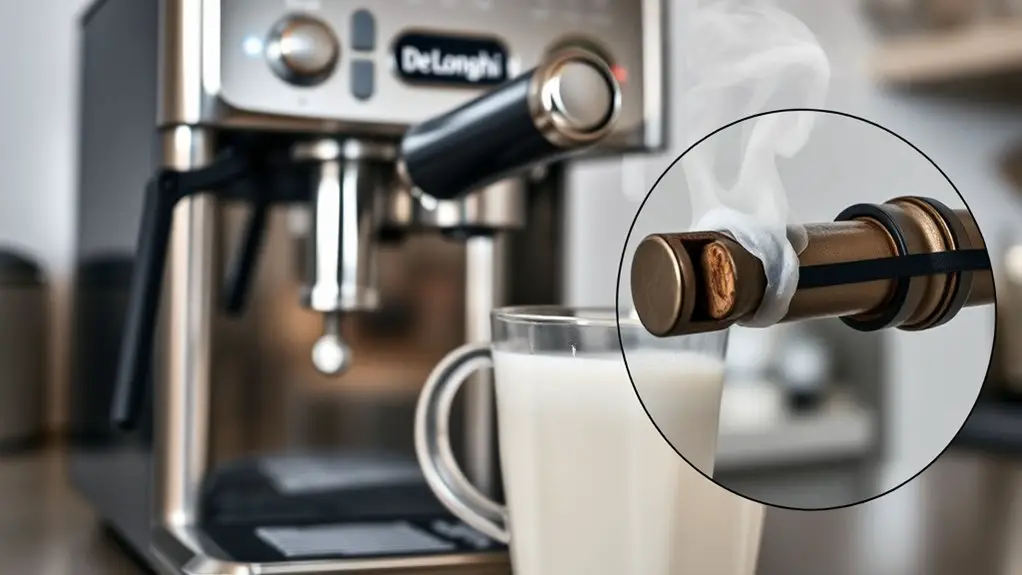If your De'Longhi machine isn't frothing milk, start by checking the milk type and temperature—whole milk works best, ideally heated to 140°F to 150°F. Inspect the frothing wand for blockages or damage, as these can hinder performance. Regularly clean your machine to prevent milk residue buildup. Confirm you've selected the proper settings for your milk type, and look for any mechanical issues like clogs or unusual noises. There's more to troubleshoot, so keep going for further solutions!
Check the Milk Type and Temperature
When you're troubleshooting frothing issues with your De'Longhi machine, the type and temperature of the milk you use are essential factors to take into account. Whole milk often froths best due to its fat content, but if you prefer milk alternatives like almond or oat milk, you'll need to choose those specially formulated for frothing. Check the temperature; milk should be between 140°F and 150°F for ideal frothing. If it's too cold or too hot, you won't achieve a good foam. Experiment with different frothing techniques, such as incorporating air slowly at first, then increasing speed. This can create a stable microfoam, enhancing your beverages. Adjusting these variables can greatly improve your frothing experience.
Inspect the Frothing Wand
Often, the frothing wand can be the source of your frothing troubles, so it is crucial to inspect it regularly. Check for any blockages or damage that could affect your frothing techniques and milk consistency. A clean and functional wand is key to achieving that perfect froth.
| Inspection Step | What to Look For | Solution |
|---|---|---|
| Blockages | Clogged holes in the wand | Clean with a pin or brush |
| Damage | Cracks or dents | Replace the frothing wand |
| Positioning | Incorrect angle during frothing | Adjust wand angle |
| Milk Type Compatibility | Suitable for frothing | Switch to a better option |
Clean the Machine Regularly
Regularly cleaning your De'Longhi machine is essential for maintaining peak performance and guaranteeing consistent frothing results. Establish a cleaning schedule that includes daily, weekly, and monthly tasks. Daily, rinse the frothing wand and milk container after each use to prevent milk residue buildup. Weekly, use a damp cloth to wipe down the exterior and descale the machine according to the manufacturer's instructions. Monthly, disassemble and clean the brewing unit and filter under warm water. These maintenance tips help avoid clogs and promote ideal functionality. If you notice decreased frothing quality, it may indicate a need for deeper cleaning or neglecting your schedule. Stay consistent, and your De'Longhi will deliver exceptional froth every time.
Ensure Proper Settings Are Selected
To achieve ideal frothing results with your De'Longhi machine, it's essential that you select the correct settings for your specific milk type and desired froth consistency. Start by choosing the appropriate frothing technique; different settings work better for whole milk versus milk alternatives like almond or oat milk. If you're using milk alternatives, verify you've adjusted the temperature and froth density settings, as they often require different parameters for best froth. Experiment with the steam wand position and angle to enhance froth creation. Remember, your machine may have presets tailored for specific milk types, so utilize them. Selecting the right settings can make a significant difference in achieving that luscious, velvety froth you desire.
Look for Mechanical Malfunctions
When troubleshooting frothing issues with your De'Longhi machine, it's important to contemplate potential mechanical malfunctions that could hinder performance. Start by checking the following components for any mechanical issues that might cause frothing problems:
| Component | Action Required |
|---|---|
| Steam Wand | Inspect for clogs; clean it. |
| Pump | Listen for unusual noises; replace if faulty. |
| Gasket | Check for wear; replace if damaged. |
| Water Tank | Verify it's seated correctly; refill if necessary. |
If you notice any irregularities, address them promptly. Mechanical malfunctions can severely impact the frothing process, so it's vital to keep your machine in peak condition.
Frequently Asked Questions
Can I Use Non-Dairy Milk Alternatives for Frothing?
Yes, you can use non-dairy milk alternatives for frothing. Choose options like oat or almond milk, ensuring they're barista blends for best frothing. Adjust your machine's settings to achieve the desired texture and richness.
How Often Should I Descale My De'longhi Machine?
You'll find that regular descaling frequency is essential for peak machine maintenance. Ideally, descale your De'Longhi every three months or after 300 cups. This guarantees longevity and consistent performance, giving you that freedom to enjoy perfect coffee.
What Is the Ideal Milk Temperature for Frothing?
When frothing milk, aim for a temperature between 150°F and 155°F. This range guarantees ideal texture and sweetness. Use this milk temperature guide for consistent results across various milk frothing techniques, allowing you more freedom to experiment.
Does the Age of My Machine Affect Frothing Performance?
You might be surprised, but yes, your machine's age can impact frothing quality. As your machine ages, its components may wear, affecting performance. Regular maintenance can extend its lifespan and guarantee ideal frothing results.
Can I Froth Milk Without the Frothing Wand?
Yes, you can froth milk without the frothing wand by using manual frothing techniques. Heat your milk, then whisk vigorously or use a jar to shake it, creating froth without steam. Enjoy your freedom to experiment!
